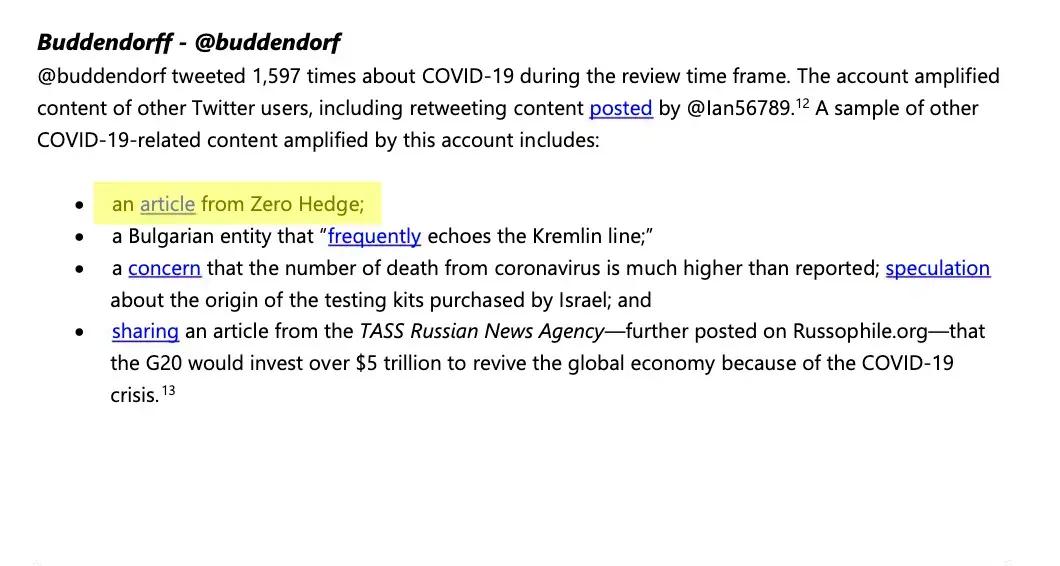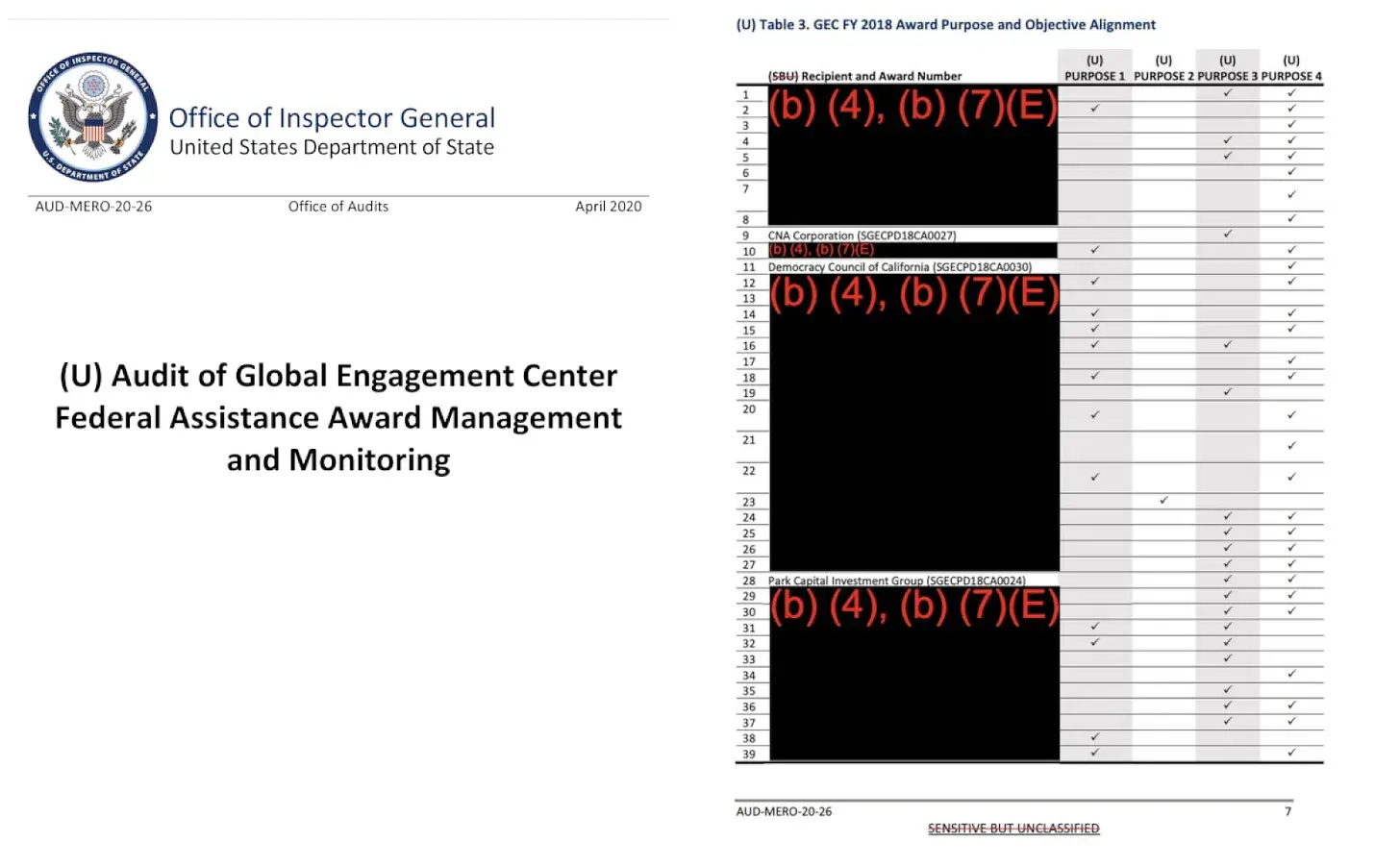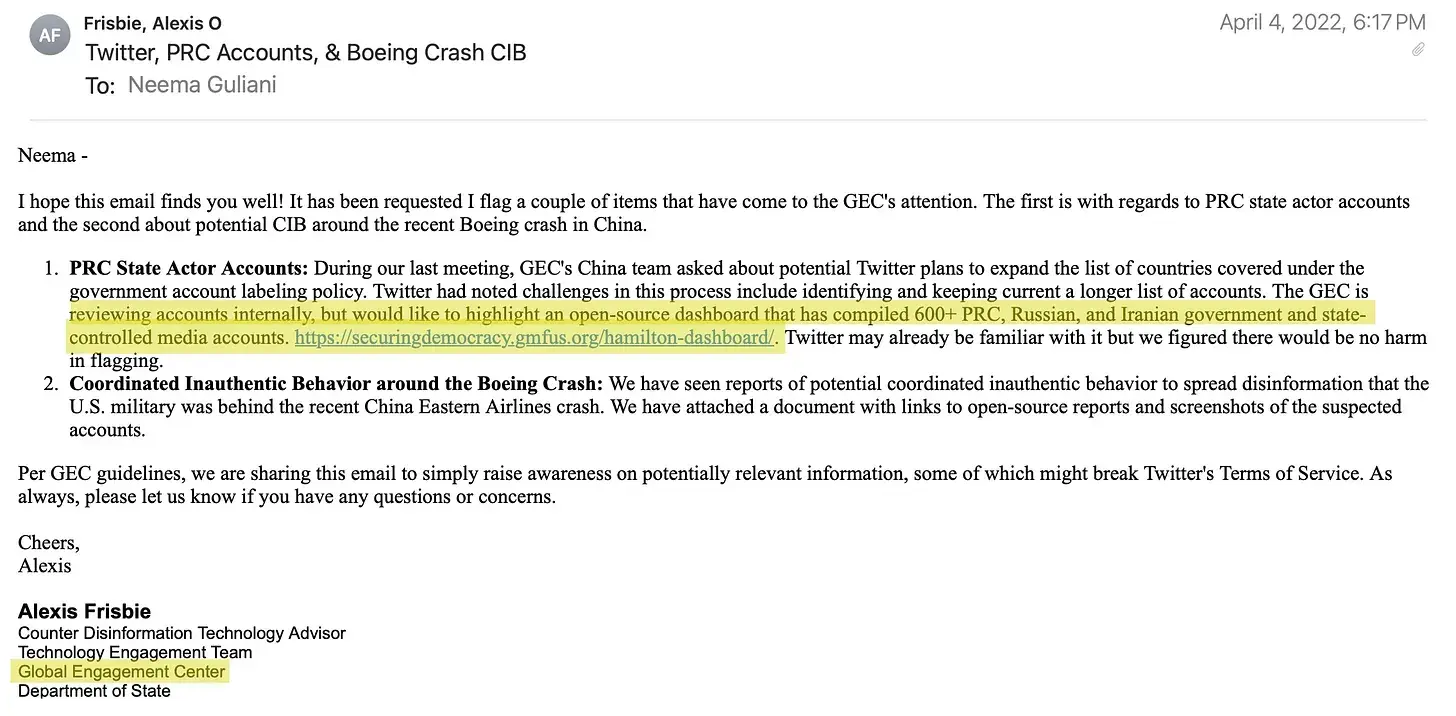The Global Engagement Center (GEC), a “counter-messaging” operation of the State Department created in Barack Obama’s last year in office, is raked over the coals in a new House investigation. The Committee’s work confirms reports by Racket and the Washington Examiner about taxpayer-funded censorship, but goes beyond to detail a more profound corruption of the agency’s ostensible mission.
“The Federal government has funded, developed, and promoted entities that aim to demonetize news and information outlets because of their lawful speech,” the House Committee on Small Business found, adding that GEC “circumvented its strict international mandate” by funding private contractors with “domestic censorship capabilities.”
Not only did the Committee find evidence the State Department strategized to discredit reporting both by me and by Gabe Kaminsky of the Examiner (see reader note, coming), it also showed the State Department blazing new trails in the annals of “the dog ate my homework” chutzpah in response to Congressional oversight requests. “Despite the fact the Committee subpoenaed documents which it had been requesting for more than 14 months,” the Committee wrote, “State said it would take approximately 21 months from the date of the subpoena to produce these documents in full — around March 2026.”
Worse, when the Committee asked GEC for basic contractor information:
Categories were provided for several recipients rather than specific organizations or individuals, such as $240,136 for “Radio Programmes” [sic] and $42,600 for “On-Air Discussion…” In six instances, subawardees were just the first names of individuals… in one instance the field denoted “Report mentions subpartners; unable to find details…”
Since January of last year, GEC has been the focus of multiple Racket and Twitter Files stories, because of its role in Stanford’s Election Integrity Partnership, the ties GEC personnel had to the infamous Hamilton 68 “Russian influence” dashboard, and other reasons. In February of last year, meanwhile, Kaminsky of the Examiner launched a brutal investigative series that began by describing GEC’s funding of the UK-based Global Disinformation Index, showing how U.S. taxpayers unwittingly funded conscious efforts to take away revenue from American businesses like the New York Post, the Federalist, and RealClearPolitics.
That latter angle inspired the Small Business Committee investigation. Chairman Roger Williams of Texas last year demanded the State Department turn over an “unredacted list of all GEC grant recipients” from 2019 through the present. As reported here at Racket and in the Examiner, Secretary of State Anthony Blinken responded with a remarkable letter. Complaining about Examiner reporting, Blinken declared that without a “better understanding” of how the Committee planned to “utilize this sensitive information,” he would only release information in an “in camera setting.” Even in camera, however, the State Department claimed lost records while submitting answers of the “We spent money on discussions and stuff” variety.
Despite stonewalling, the Committee was able to answer a slew of key questions raised in nearly two years of reporting. The struggle to identify GEC’s contractors (especially those with stateside presences) ultimately revealed a larger ugly truth, namely that the ostensibly outward-facing State Department is pouring resources into a broad new propaganda mission at home:
In December 2022, while poring through correspondence at Twitter headquarters in San Francisco with Michael Shellenberger, Bari Weiss, Lee Fang and others, I came across emails between Twitter executives about GEC. Created by Obama to counter messaging “directed at foreign audiences abroad,” GEC soon turned its attention to domestic speech. By early 2020, this new State Department censorship arm hoped to join the FBI, Homeland Security, and others in helping Twitter police content.
“GEC’s blitz on these issues is at least in part an attempt to insert themselves into the conversations we’ve had with DHS, FBI, ODNI, and others,” Trust and Safety chief Yoel Roth wrote on May 6, 2020. Roth worried about letting State into the censorship trust tree, noting ominously “the GEC’s mandate for offensive [information operations] to promote American interests.” In less than a year Twitter rolled over, banning accounts GEC said were “GRU-controlled” despite a lack of clear evidence. Former CIA official-turned-Twitter exec Patrick Conlon commented on the turning-point moment: “Our window on [refusing] is closing.”
GEC soon began to pop up in correspondence related to Stanford’s Election Integrity Partnership (EIP), which was aggregating election “misinformation” complaints for Twitter and other platforms. This was problematic because both Twitter analysts and outside partners like the FBI seemed to be constantly complaining that GEC was sloppier and more politicized than other “anti-disinfo” groups.
Its methodology was “shoddy” and “pretty bogus,” said Roth. An analyst who’d trained the State Department to look for bad actors added that GEC was “more ideologically aligned than evidence-based.” As an example, he noted GEC “attributes membership in the yellow vests as being Russia-aligned,” and believed that “agreed with Moscow-aligned narratives = Moscow controlled.” In GEC country reports, some of which later became public, GEC formalized guilt by ideological association through a concept called the “information ecosystem,” under which accounts not directly tied to bad actors could nonetheless be labeled “highly connective.” Former Italian Prime Minister Giuseppe Conte and Italian Democrat Nicola Zingaretti were among those demerited for spreading “legitimate and accurate” content that “attacks Italian politicians, the EU, and the United States.”
GEC’s idea of defining “ecosystems” to help bridge the gap between accounts with “clear links to Russia” and those “that are meant to be fully deniable” turned out to be easy to twist in the direction of US-based accounts.
When Twitter in the summer of 2020 agreed to label Chinese state accounts, GEC called that a “welcome step,” but asked if they could go a little further and consider “accounts run by organizations and media that heavily promote CCP propaganda media content.” Similar notices were sent about media in the Russian “ecosystem.” Who might qualify? GEC had already sent Twitter a report in February 2020 complaining about “flurry of disinformation” caused by the suspension of the well-known Zero Hedge account. In a report sent about “Russia-linked” media figures that were supposedly “sowing discord in France,” a now-suspended account called @buddendorf was dinged by GEC just for sharing a Zero Hedge article:

The New York Post last week reported that the State Department circulated an internal memo strategizing talking points to poke holes in reports by Kaminsky and me. The memo described in Christenson’s “State Department tried to discredit reporters” story is more amusing than scary. memo is more amusing than scary. It contains lines like “GEC does not and has never attempted to moderate content on social media platforms,” which is a little like Starbucks saying it never sold coffee. GEC’s claim that it never tried to “moderate” content is a semantic somersault: that above the gigantic lists of account names it sent to the platforms, it wrote things like “Below is an initial list of accounts that Twitter could consider,” instead of “Zap all 5000 of these.”
While the Twitter Files focused on “content moderation,” Kaminsky began looking into the funding of British outfit GDI. He found GEC’s connection to GDI through the good old-fashioned journalistic method of being a pest.
“During the months that I was first looking into GDI, I noticed that the British group listed one of its supporters on its website as Park Advisors, a counterterrorism firm affiliated with the State Department,” he says. “It was only after repeatedly contacting the State Department that the agency informed me that its Global Engagement Center awarded $100,000 to GDI through Park Advisors. The award was for a program that counted the Atlantic Council as a partner, among other organizations.”
The issue wasn’t the size of the award, but rather what that money funded. GDI puts out a product called a “Dynamic Exclusion List” — a blacklist— designed to help firms like Google “eliminate digital advertising as a revenue source” for disfavored outlets. Nearly all GDI’s blacklisted outlets were conservative, while NPR (rated “neutral, fact-based content”) and The Atlantic (a perfect 100/100) topped trust lists.
In efforts to investigate GEC, Kaminsky and I ran into the same problem: almost no other records of GEC contractors were public. An April 2020 audit of GEC by the State Department Inspector General showed a list of 39 agency contractors. As noted here before, 36 were redacted. If GEC was funding one contractor like GDI that impacted domestic news in defiance of State’s explicit legal mandate to keep its eyes overseas, how many other such contractors were there? What mischief was under these black boxes?

There were other reasons for wanting to know those contractor names. I’d learned by then that former GEC personnel helped design the Hamilton 68 dashboard, which Twitter executives decried as “bullshit” that falsely accused “a bunch of legitimate right-leaning accounts of being Russian bots.” Sources in government told me to dig there and to not stop digging. The Twitter Files themselves spurred curiosity. Multiple GEC communications suggested Twitter execs make use of the Hamilton dashboard, or contact its parent organizations, the German Marshall Fund and the Alliance For Securing Democracy. I never published those communications, but for example:

For that reason, I raised an eyebrow at the new Committee report, which contains an entry about GEC briefing employees at Zoom. “Zoom staff asked about ‘lists’ that could be shared around ‘malign actors,’” the Committee wrote, “to which the GEC recommended the GDI and the Hamilton 2.0 dashboard”:

By the end of the Twitter Files project it was clear some NGOs and quasi-private entities who produced “anti-disinformation” tools for journalists, platforms like Twitter, and law enforcement agencies were receiving funding from GEC. This was odd for a few reasons, including the fact that there were so many complaints within Twitter about its methods. Eventually, in a deposition for the Murthy v. Missouri digital censorship case, FBI agent and Twitter Files all-star Elvis Chan complained about GEC and its universe of sub-contractors:
Q. And so your concern… was that the GEC’s kind of computer programs that they were making available to social media companies might be overinclusive and misidentify authentic accounts as inauthentic activity?
CHAN: So the State Department is primarily a foreign-focus agency. I believe that in their estimation their tools would be deployed overseas, where I believe they do not have the same type of legal training that I do specifically about First Amendment protections. And so, you know, they are overseas in embassies and their analysts are overseas in embassies, and so they don’t have the same sorts of concerns that I would working at the FBI.
The House report raises these concerns and more, explaining why having a State Department entity marionetting American media traffic is a grave problem. “A foundational principle of American markets is that a business will be able to operate without unreasonable interference from the government so long as they obey the law,” the Committee staff wrote. However, they added, “the Federal government worked with the private sector extensively in recent years to remove or suppress certain disfavored speech… impacting the ability of businesses purveying that speech to use those services to compete.”
Contractors GEC employed used preposterous criteria to downrank media companies. The British site Unherd was demerited by GDI because it publishes Kathleen Stock, a “‘prominent gender-critical’ feminist.” The firm also considered the term “illegal alien” to be disinformation. Most ludicrously, it slammed sites like The New York Post, Reason, and The American Spectator for use of “sensational” language, apparently employing a subjective conception of the term. As the Committee wrote:
The Washington Post was assigned a low risk level as it “largely avoids sensational […] reporting.” It is clear from looking at recent headlines from opinion pieces such as “Yes, It’s okay to compare Trump to Hitler. Don’t let me stop you” and “Can anyone stop the coming Trump dictatorship?” that The Washington Post does not shy from sensationalism…
The Global Disinformation Index is just one GEC contractor and it estimates that between launch and 2022, sites on its “Dynamic Exclusion List” have “lost $128 million in annual revenue.” Our government has always been terrible at reaching the population using sites like RFE/RL or Polygraph because you can’t buy audience. You can, however, very easily cripple disfavored views using tools like GDI or NewsGuard. Trust is hard. Damage is easy, and even the dolts in our government can manage it.
The State Department has spent decades learning to make simplistic decisions overseas about which politicians the U.S. should support, and which it should discourage or even topple. It spends gobs on that mission, working in concert with “Democracy Promotion” bureaucracies like the NED (whose efforts to influence speech are also profiled in this report). It’s impossible to imagine anything more destructive than letting the government meddle in domestic politics with the same monomaniacal bluntness it employs abroad. According to this report, it’s already doing it, and will be damned if it will submit to oversight from anyone, even Congress.

Ok, i’ll bite.
While I get the instance name is lost on some visitors, it’s fascinating to see Republican campaign material posted here in complete seriousness. So much about how dare the government possibly have impeded people heavily involved in far right campaigns in making money off distracting the working class with made up culture war. How dare other private businesses want to throw the out and proud Nazi’s off their platform.
A few offhand points, it is absolutely within the State Department’s remit to identify foreign infuance campaigns, even if they don’t always get it right.
The fact that the Twitter Files also showed that companies can and did push back on numerous recommendations after their own investigation disagreed without repercussions would seem to be pretty damming evidence that they really were recommendations about potential misinformation accounts and not government censorship.
Similarly, the comments on identifying misinformation is based on the ludicrous idea that there is just no possible way for an investigation to tell the difference between a truth and an outright lie, and thusly anyone attempting to do so or tell others about the serial liar much be censoring them.
The best evidence that the government isn’t actually trying to censor these group is government doesn’t use this sort of lukewarm, you might want to take a look at these accounts methods on pleople who it actually wants to censor like leftists, they just declare them a potential terror theat and send the FBI or police in to rough up the environmental group or activists.
But hey, they called the New York Post sensationalist and massive transphobe campaigning to get trans people banned from public restrooms prone to misinformation, so I guess the deep state really is censoring poor Donald Trump and his friends and we should be outraged not at the blatant campaign to mislead the poor into voting against their interests, but of the most lukewarm, liberal, halfhearted response possible to it.
In short, get back to me when they’ve done something more than politely ask the mods to look into a questionable user, like have even approached the sort of things they do people trying to block pipelines on a weekly basis.